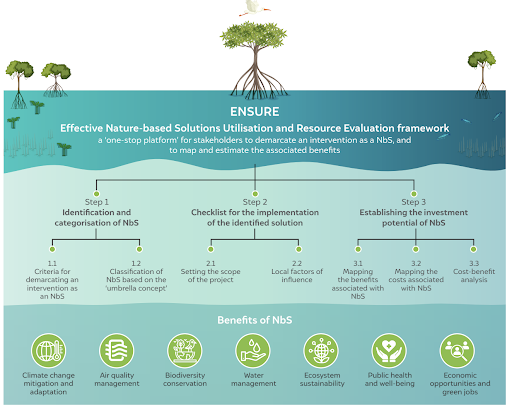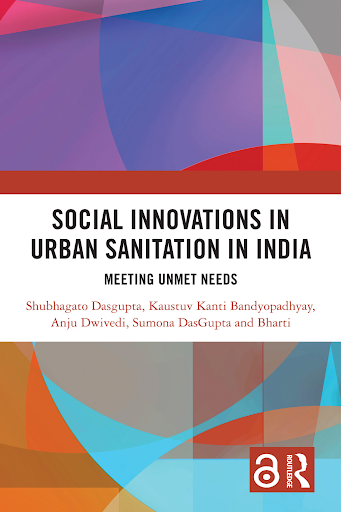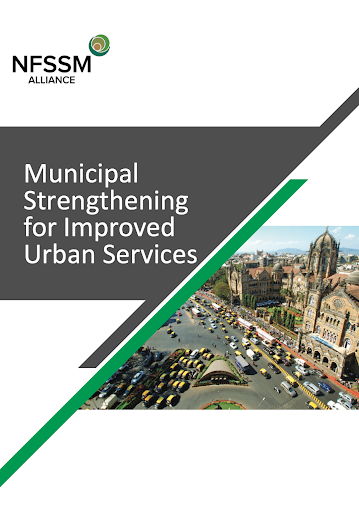
THEME OF THE FORTNIGHT
WATER AND SANITATION
REPORTS
Accelerating Investments for Nature-Based Solutions in the Global South: A Unified Framework for Mapping and Estimating Benefits

Author(s): Shreya Wadhawan and Aryan Bajpai
Publication Details: Council for Energy Environment and Water, 2024
An effective approach to mitigating climate impacts is deploying nature-based solutions (NbS). NbS encompasses a broad range of strategies that utilise natural processes and ecosystems to reduce flooding, sequester carbon, preserve biodiversity, and enhance living standards by providing fresh air and clean water amongst others. Although the benefits of NbS are recognised globally, their financing and implementation often fall short of proposed targets. The absence of standardised measures and reporting on the impacts of NbS make it difficult to evaluate their effectiveness and consequently, hinder investments in this sector and the scaling up of successful projects.
This report proposes a common assessment framework that can help stakeholders evaluate the economic and non-economic benefits of NbS. This involves (i) Identifying an intervention as an NbS. The criteria are essential to ensure that the interventions are contextually relevant and beneficial for the region of implementation, keeping in mind its socio-economic and geographical characteristics. (ii) Demarcating its benefits in terms of social, environmental, species-related, economic, livelihood-related and cultural aspects. (iii) Estimating the cost-to-benefit ratio by providing a standardised approach to assess and report on their outcomes and costs.
The framework can be adapted to diverse socio-economic and environmental settings, thus making it particularly relevant for countries located in the Global South. As the scale of development continues to accelerate both at national and global levels, the framework can be updated regularly to maintain its relevance and importance.
The Economics of Water: Valuing the Hydrological Cycle as a Global Common Good

Author(s): Global Commission on the Economics of Water
Publication Details: 2024
To radically transform both water use and supply requires a shift from siloed and sectoral thinking to an economy-wide approach to the entire water cycle including both blue and green water, that shapes and crowds in innovations. The report offers a set of recommendations to make this transition. Some of these include:
- Governing the hydrological cycle as a global common good, recognising our interdependence through both blue and green water flows
-
Recognising the minimal water requirements of water for a dignified life. This report offers 4,000 l/p/d as a reference for further discussion
-
Pricing water properly to incentivise its conservation, particularly by the largest users
-
Shaping markets to spur a wave of mission-oriented innovations, capacity-building and investments across the entire water cycle. These investments must be evaluated not in terms of short-run costs and benefits, but for how they can catalyse dynamic, long-run economic and social benefits
-
Enabling a clean-energy and AI-rich era with much lower water intensity
-
Reprioritising government budgets to focus on investments in water, and repurpose environmentally harmful subsidies
-
Accelerating efforts toward market-based disclosure of corporate water footprints, and expediting work towards regulatory standards for mandatory disclosure, so as to steer action toward sustainable water practices
The report aims to establish a Global Water Pact that sets clear and measurable goals to stabilise the hydrological cycle and safeguard the world's water resources for a sustainable and just water future.
Read More: https://economicsofwater.watercommission.org/report/economics-of-water.pdf
Social Innovations in Urban Sanitation in India, Meeting Unmet Needs

Author(s): Shubhagato Dasgupta, Kaustuv Kanti Bandyopadhyay, Anju Dwivedi, Sumona DasGupta and Bharti
Publication Details: Routledge India, 2023
This report examines effective social innovation strategies employed by civil society organisations (CSOs) to address India’s significant urban sanitation challenges. It outlines an ecosystem that encourages citizen participation and enhances community-managed systems to improve sanitation and public health. The report analyses case studies of successful sanitation programs as well as experiments with innovative ideas in various regional contexts, focusing on how CSOs can meet the specific needs of communities and ensure access to safe sanitation, particularly for the urban poor. It emphasises the challenges faced and the necessity for active community involvement to drive behavioural change, as well as the importance of increasing the institutional capacities of municipalities to standardise and scale successful strategies. The report also stresses the need to design low-cost solutions, organise informal sanitation workers, support marginalised communities, and foster effective partnerships between communities and institutions to influence public policy.
Municipal Strengthening for Improved Urban Services

Author(s): NFSSM Alliance – BMGF, CWAS, Dasra, EY, IIHS, UMC
Publication Details: NFSSM Alliance, 2022
The report emphasises the critical importance of robust municipal governance in urban India, particularly regarding delivering essential services like sanitation and water supply. As urban populations continue to grow, the demand for effective service delivery intensifies, revealing significant gaps in infrastructure and management. This report analyses current challenges faced by municipal governments, including resource constraints, governance issues, and inadequate service provision. It advocates for targeted strategies to strengthen local governance structures, enhance capacity building, and foster community engagement in the planning and execution of urban services. By prioritising the development of strong municipal institutions, the report aims to facilitate sustainable improvements in service delivery, ultimately ensuring that all urban residents, especially marginalised communities, have access to reliable sanitation and clean water. Through a framework of best practices and actionable recommendations, this report serves as a guide for policymakers and stakeholders committed to enhancing urban governance in India.
Read More: https://www.nfssmalliance.org/reports/municipal-strenthening-report
RESEARCH PAPERS
Blue-Green Infrastructure in View of Integrated Urban Water Management: A Novel Assessment of an Effectiveness Index
Author(s): Jacqueline Carril Ferreira, Daniel Costa dos Santos Luiza C. Campos
Publication Details: Water Research (Elsevier) 2024
Since the early 2000, Integrated Urban Water Management (IUWM) has been widely promulgated as a sound philosophy for urban water management. Implementing IUWM requires a holistic view and systemic approach due to the complex nature of the urban water systems, which typically encompasses water supply, wastewater, and stormwater collection subsystems. To truly operationalise IUWM in the right spirit, there is an imperative need to choose solutions that suit the local context and promote community engagement. In this context, blue-green infrastructure (BGI) has emerged as a solution to enhance the resilience of urban areas and mitigate climate change impacts, even in informal settlements. By integrating vegetation and water management, BGI measures effectively reduce the impact of urbanisation on the water cycle. BGI, comprising green roofs, urban parks, street trees, ponds, permeable pavement, and wetlands, provides multiple benefits for urban water management and ecosystem services. Evaluating the effectiveness of BGI interventions requires a systemic approach to accurately measure benefits.
This research employed the Urban Water Use model to assess the effectiveness index of BGI measures because of IUWM. The procedure included mathematical modelling, expert meetings for scenario building and, resident interviews to capture the community's vision. To assess the impact of IUWM on the effectiveness of BGI measures, the research simulated with BGI only and then three simulations with improvements to the water and sewage systems. The results revealed that implementing BGI measures without the IUWM approach does not guarantee a more sustainable environment. On the contrary, there is an improvement in the effectiveness of BGI measures through the combination of IUWM.
Read More: https://www.sciencedirect.com/science/article/pii/S0043135424005591
Analysis of Urban Wetland Park Cooling Effects and Their Potential Influence Factors: Evidence From 477 Urban Wetland Parks in China
Author(s): Yue Deng, Yuan Yao, and Lin Zhang
Publication Details: Ecological Indicators (Elsevier), 2023
Urban wetland parks can lower surrounding temperatures efficiently and play a critical role in mitigating extreme urban high-temperature weather. Understanding urban wetland park cooling effects and their influencing factors is necessary for the management plan of urban parks. This research study focused on 477 urban wetland parks classified under river-based and lake-based urban wetland parks. It investigated the urban wetland park cooling effects during the warm (April-September) and cold (January-March, and October-December) seasons.
The results revealed that, both river–based and lake–based urban wetland parks exhibit a stronger cooling effect during the warm season. The water cover inside urban wetland parks has more influence on cooling compared to vegetation cover.
The study recommends any new park should limit impervious layers to below 13 percent and ensure the proportion of water bodies is at 70 percent, at least to obtain a stronger cooling effect.
Read More: https://www.sciencedirect.com/science/article/pii/S1470160X23012451
The Potential Application of Non-Sewered Sanitation Systems in Healthcare Facilities: A Case Study in Beijing, China
Authors: Shikun Cheng, Qizhi Zhao, Chongqiu Wen, Musa Manga, Rui Xiang, Xuemei Wang, Zifu Li
Publication Details: Journal of Water, Sanitation and Hygiene for Development, 2024
Non-sewered sanitation systems (NSSSs) could improve sanitation in healthcare facilities (HCFs) within urban areas of developing countries. However, they are not usually applied in these areas. In this study, the PEST (political (P), economic (E), social (S), and technological (T)) analysis refers to analysing the feasibility and potential of a project in terms of four factors – political, economic, social, and technological – was used to examine the practical application of NSSS in HCFs in Beijing, China. The results found that the support of NSSS applications in HCFs outweighs the challenges. Particularly in rural areas, NSSS has significant potential for application. Implementing these strategies would enhance sanitation in HCFs and reduce the spread of diseases.
Read More: https://iwaponline.com/washdev/article-pdf/doi/10.2166/washdev.2024.280/1504616/washdev2024280.pdf
The Clean Plan: Analysing Sanitation Planning in India Using the CWIS Planning Framework
Author(s): Abhishek S. Narayan, Max Maurer, Christoph Lüthi
Publication Details: Journal of Water, Sanitation and Hygiene for Development, 2021
Sanitation in India has received national attention for over a decade, especially with the Swachh Bharat Mission (SBM) making it a political priority. However, due to a lack of appropriate sanitation planning practices, there have been few long-term gains in urban sanitation beyond eradicating open defecation. The paper analyses key barriers to sanitation planning in India, in the context of the emerging Citywide Inclusive Sanitation (CWIS) paradigm. A mixed method approach using shit flow diagrams (SFDs), social network analysis, policy analysis, interviews and workshops at the national, state and city levels were conducted. Eight factors were identified as important barriers to planning, including inadequate planning capacities, lack of ownership of city sanitation plans among city governments, poor community involvement, absence of a uniform planning framework, unreliable political and financial support, overlapping jurisdictions, and scheme-based funding. The paper also proposes the CWIS Planning Framework which offers a perspective on overcoming these barriers with the recommendation of bridging top-down and bottom-up planning approaches. While there is increasingly more clarity on what CWIS means, there needs to be more understanding of how to plan for it. Therefore, this framework provides the theoretical basis for planning with the CWIS approach.
Read More: https://iwaponline.com/washdev/article-pdf/11/6/1036/966642/washdev0111036.pdf
National Institute of Urban Affairs
1st Floor, Core 4B, India Habitat Centre, Lodhi Road, New Delhi -110003, India
Telephone: (011) 24634971, 24643576
Email: director@niua.org • Website: niua.in





